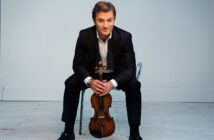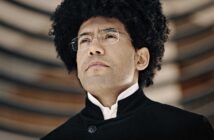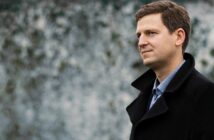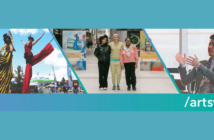Wagner: Tristan und Isolde: Prelude and Liebestod
Beethoven: Piano Concerto No. 2 in B flat major Op. 19
Stucky: August 4, 1964: Elegy
Strauss: Der Rosenkavalier: Suite
Anton Nel, piano
Dallas Symphony Orchestra/Jaap van Zweden
Dallas, Texas
February 22, 2013
For five years now, Dutch conductor Jaap van Zweden has been working steadily to build the Dallas Symphony (DSO) into a world-class orchestra. Critical reaction in Dallas has been consistently glowing and when conductor and orchestra were featured at the League of American Orchestras Conference in Dallas last year, the reaction from the ‘movers and shakers’ in the industry was ecstatic.
 Now comes the biggest test of all. In a few weeks, the DSO will embark on its first European tour with van Zweden on the podium. Vienna, Amsterdam, Munich and Hamburg will weigh in on what van Zweden has achieved. In preparation, the Dallas Symphony is honing its two tour programs on home turf; based on what I heard last week, there is reason for great optimism.
Now comes the biggest test of all. In a few weeks, the DSO will embark on its first European tour with van Zweden on the podium. Vienna, Amsterdam, Munich and Hamburg will weigh in on what van Zweden has achieved. In preparation, the Dallas Symphony is honing its two tour programs on home turf; based on what I heard last week, there is reason for great optimism.The first of the tour programs is devoted to music by Wagner and Richard Strauss, with an added dash of American content, in the form of Steven Stucky’s (photo: above right) eight-minute Elegy. In the Dallas concerts, Anton Nel was featured in Beethoven’s Piano Concerto No. 2. In Europe, the Beethoven will be replaced by Korngold’s Violin Concerto with Hilary Hahn as soloist. Later this week, the DSO will test drive its other tour program, which features Mahler’s Symphony No. 6.
DSO/van Zweden Wagner Glows from Within!
The music of Richard Wagner is part of Jaap van Zweden’s core repertoire. In Holland, he has already made complete recordings of Lohengrin, Die Meistersinger and Parsifal, each of them impressive for its command of structure and flow, and for a rare ability to balance complex textures. These characteristics were evident again last week in the Dallas Symphony performance of Wagner’s Prelude and Liebestod. Van Zweden’s tempi in this piece were a little fast for my taste, but there was no denying the quality of the playing or the authority of the conducting.
From the opening bars of the Prelude, van Zweden made clear that this was music of great intimacy. The crescendi in the cellos were not overdone, and led inexorably, initially to the first strong accent heard only in the cellos (third phrase, bar 10), and then to the full-throated fortissimo (bar 17). All this structural context was beautifully illuminated by van Zweden, with extraordinarily refined playing from his cello section. As for the tempo: in these 15 bars, there are numerous rests and pauses between phrases. It does make excellent musical sense not to exaggerate these
silences. While I agree that if the conductor takes too slow a tempo here, the arc of those 15 bars can be completely lost, I nevertheless believe that it could be preserved with a slightly more relaxed tempo than that taken by van Zweden.
silences. While I agree that if the conductor takes too slow a tempo here, the arc of those 15 bars can be completely lost, I nevertheless believe that it could be preserved with a slightly more relaxed tempo than that taken by van Zweden.
That said, this Wagner glowed from within, from those yearning opening cello phrases to the final resolution of love and death at the end of the Liebestod. Van Zweden reminded us that this is not a Götterdämmerung-category climax, but something more human and profound. For all the passionate seething in the music, the final climax, while rich and all consuming, is restrained. The dynamic marking in the score is forte – not fortissimo – and certainly not fff.
There are no cheap effects in this music; van Zweden made sure his musicians understood that and they gave him a deeply felt, perfectly balanced climax. This was sublime music making.
The piano soloist on this evening’s program was Anton Nel (photo: right), an artist well known to those of us who spend a lot of time in Austin, Texas. Nel heads the piano faculty at the Butler School of Music and is known to be masterly in a vast repertoire. He plays frequently in Austin, where he was recently featured in the regional premiere at the Zach Theatre, of 33 Variations, a play which makes extensive use of Beethoven’s Diabelli Variations.
Nel and van Zweden were remarkably attuned to each other in this performance of Beethoven’s Piano Concerto No. 2, with transitions and dynamics perfectly dove-tailed. Van Zweden and the DSO recently concentrated on compositions by Mozart for a two-week festival and this work paid off in this performance of the piano concerto, an early Beethoven piece.
Under van Zweden’s direction, the strings of the Dallas Symphony demonstrated how adept they have become at switching from late-Romantic Wagner to Classical Period Mozart and Beethoven. It is a completely different world of bowing, dynamics and articulation and few modern orchestras can do it convincingly. Anton Nel played beautifully throughout and his control of dynamics in the slow movement was outstanding.
One of Our Own: The Right Choice Better than None at All
After intermission came Stucky’s Elegy (from August 4, 1964), the one American work the DSO is taking to Europe, raising the question: “Shouldn’t American music be better represented on a foreign tour than with an eight-minute piece?” Absolutely. But then, Washington’s National Symphony recently went off to Europe without a single American work in its repertoire; inexcusable for the resident orchestra of the Kennedy Center in the nation’s capital.
In defense of the Dallas Symphony, I will point out that van Zweden and the DSO gave the world premiere of Stucky’s August 4, 1964in September, 2008, and took it to Carnegie Hall in 2011. Around the same time, they recorded the piece; in other words, they are hugely invested in this full-length concert drama, and this exciting eight-minute highlight is better than nothing, considering that European promoters find major contemporary works a tough sell in programs by touring orchestras.
In spite of its brevity, Stucky’s Elegy is a powerful and compelling piece, with some vivid contrasts between solo strings and mournful brass. Van Zweden and the DSO gave it a stunning presentation. European listeners exposed to this excerpt from the piece, may well be inspired to check out the complete work.
Dallas Symphony Truly in Top Form for European Tour
The concert finished with the performance of a suite from Richard Strauss’ opera Der Rosenkavalier. Several suites from the opera, which are played more often, give us little more than a taste of the merry waltz music. This suite, possibly put together by the young Leonard Bernstein, is more ambitious. Starting with the exuberant opening bars of the opera, it goes on to the Presentation of the Rose, then gives us much of the glorious final trio and duet, ending with the waltz music in all its unfettered high spirits. This suite has a wide range of moods and dynamics and represents a considerable challenge for a virtuoso orchestra.
No problem for the rejuvenated Dallas Symphony. One marveled both at the quality of the solo playing and the tightly unified ensemble playing. Van Zweden has made upgrading the strings a to
p priority and it shows. Few orchestras anywhere today can boast of so many topnotch musicians in its ranks. The two concertmasters, Alexander Kerr and Nathan Olson, both of whom contributed very distinguished solo playing to the Strauss performance, were backed up by equally fine players – Gary Levinsonand Emmanuelle Boisvert (former concertmaster of the Detroit Symphony) – behind them at the second stand.
p priority and it shows. Few orchestras anywhere today can boast of so many topnotch musicians in its ranks. The two concertmasters, Alexander Kerr and Nathan Olson, both of whom contributed very distinguished solo playing to the Strauss performance, were backed up by equally fine players – Gary Levinsonand Emmanuelle Boisvert (former concertmaster of the Detroit Symphony) – behind them at the second stand.
The horn section is also one of the glories of the “new” Dallas Symphony. The orchestra is actively looking for a principal to replace Gregory Hustisand is trying out candidates from other orchestras. In this concert, DSO Associate Principal David Heyde led the section in the Wagner and third horn David Cooper was the principal for the Strauss. Both were excellent, although Cooper had more to do and did it with exceptional confidence and phrasing. The entire section played with electrifying power and bravura.
Notably absent from this concert was another outstanding young principal player. Principal trumpet Ryan Anthony has been forced to withdraw temporarily due to illness. Let us hope this wonderful musician will soon return to take his rightful place in the orchestra. At last week’s concert and on the tour, his replacement is Manny Laureano, principal trumpet of the Minnesota Orchestra.
I’ll return to Dallas later this week to report on the orchestra’s other tour program featuring Mahler’s Symphony No. 6.
Paul Robinson is the author of Herbert von Karajan: the Maestro as Superstar, and Sir Georg Solti: His Life and Music. For friends: The Art of the Conductor podcast, “Classical Airs.”
















